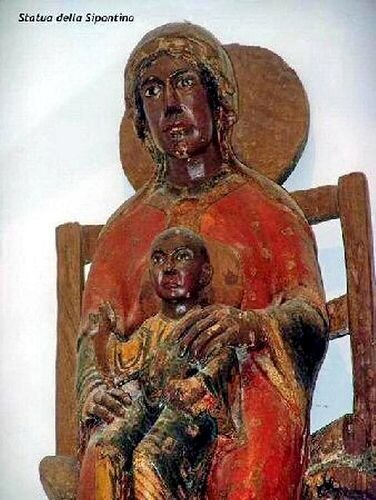Manfredonia/Siponto
La Sipontina, Madonna dagli Occhi Sbarrati, (Madonna of the Staring Eyes), Protectress of Victims of Sexual Abuse (my declaration!)
Madonna of the Staring Eyes after renovation
Madonna of Siponto, Patroness of Manfredonia
Madonna of Siponto after renovations
A copy on the bell tower shows the earlier black face of the Patroness of Manfredonia/Siponto
In the cathedral Duomo di Manfredonia/Cattedrale di San Lorenzo Maiorano, statue in the crypt, icon in the upper church, Via Arcivescovado, 71043 Manfredonia FG, wood, 5th century A.D., almost life-size.
In the cathedral of Manfredonia there are two important images of Mary. It seems that together they were brought to Siponto from Constantinopel in the 5th century by the first bishop of Siponto, Lorenzo Maiorano.¹ The city was an important ancient port town and seat of the bishop, but after earthquakes and the founding of Manfredonia in 1256, Siponto gradually lost power to the new city, into which it has now been incorporated. With that shift of power came a conflict over the ownership of the two sister Black Madonnas. At one point the Manfredonians tried to bring them to their town by force when lo, suddenly such a strong storm arose that they figured the Black Madonnas insisted on staying put. Similarly in 1620 the Turks tried to kidnap them, but they returned miraculously to their home church, Santa Maria di Siponto, which was built on top of a temple to the goddess Diana. Here they remained until 1973.
The icon of the Madonna of Siponto was long one of those attributed to St. Luke the Evangelist and said to be one of the “Seven Sisters”.² It was a more obvious Black Madonna until it needed restoration after a fire and was whitened to its original color. A copy of its former looks is kept outside, under the bell tower.³ This Patroness of Siponto and Manfredonia has been restored twice, in 1896 and in 1927, and was canonically crowned in 1955. On her feast day, August 30-31, the greatly beloved icon is taken around the city for big processions and venerated by many thousands of participants.
Meanwhile the statue in the crypt, the Black Madonna Sipontina, was forgotten for a time. Some old traditions say the intermittent loss of Siponto had to do with the Madonna in the crypt. She is called the Madonna of the Staring Eyes, because, according to tradition, one day she witnessed an act of serious violence. Right at the foot of her statue the nephew of the bishop raped Catella, the devout daughter of Evangelio, deacon of the cathedral. After this incident the poor girl tried to drown herself in the sea, but it brought her back to land and, as a legend tells, in memory of her tears “Salso Lake”, the marshes in the area, were formed. The eyes of the Madonna, once sweet, kept getting wider and wider each day that past after the incident, until the perpetrator was brought to justice. The story is retold in the 6th century letters of Pope St. Gregory the Great to the bishop and other authorities. — No wonder people tried to forget this Madonna with the accusing eyes! Would that every victim of sexual abuse had such a holy witness calling attention to the crime and demanding justice!
15 km North-East of Manfredonia is another important holy place, the cave on Monte Sant’Angelo where the archangel Michael appeared in 491 to some shepherds.
Footnotes:
1. Some still list the 11th or 13th century as their time of origin, but those theories were disproven in recent restorations. The best article on this is The icon of Siponto.
2. The Madonna of Manfredonia/Siponto, the Madonna of the Seven Veils in Foggia, the Madonna of the Succor of San Severo, the Crowned Madonna of Apricena, La Madonna di Stignano a San Marco in Lamis, the Madonna of Crist in Rignano, and the Black Madonna of Lucera.
3. The photo of her on the bell tower and much of this information is taken from the great article by Marisa Uberti, “Siponto, Manfredonia e le Madone Nere”





